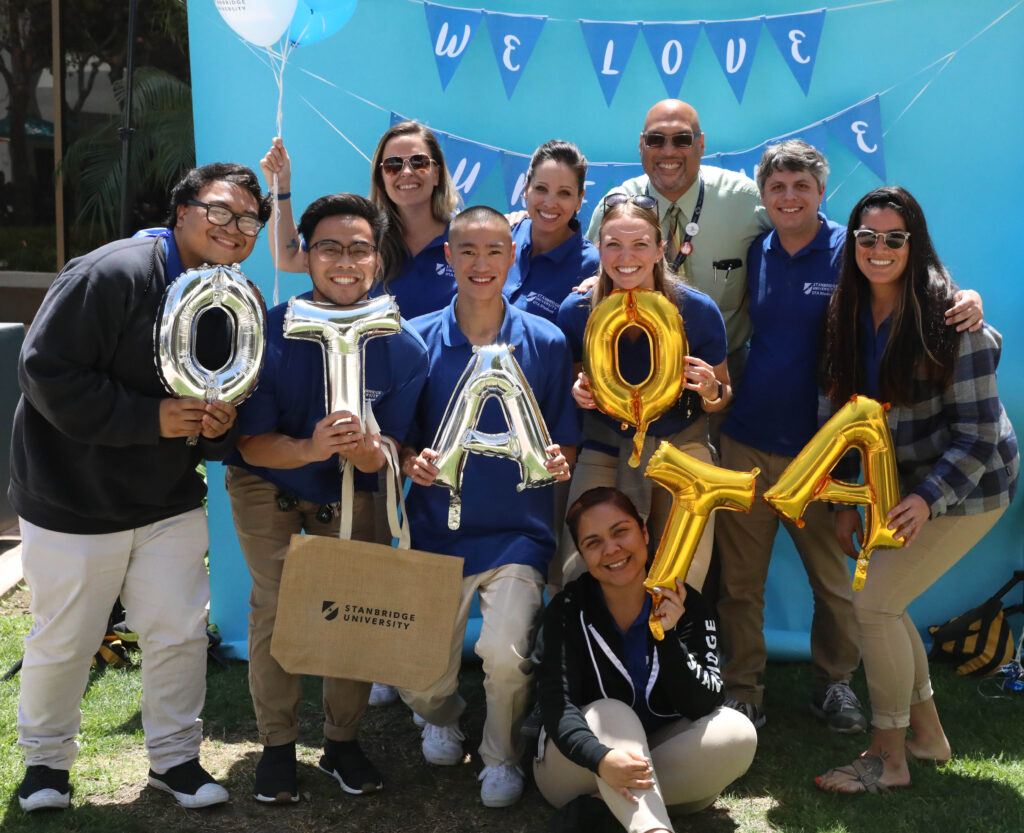The Role of an Occupational Therapy Assistant Explained

What Is an Occupational Therapy Assistant?
What is an occupational therapy assistant? OTAs work under the supervision of licensed Occupational Therapists to help people regain independence after injury or illness.¹ Occupational Therapists (OTs) are licensed professionals who assess patients, create treatment plans, and oversee therapy programs.² The OTA field continues to grow, especially in states like California, where job demand remains high.³ The role typically requires an associate degree, such as the one offered through Stanbridge University’s Occupational Therapy Assistant program, which takes about 22–23 months to complete.⁴
What is an occupational therapy assistant? It’s a question many people ask when exploring meaningful careers in healthcare. An Occupational Therapy Assistant, often called an OTA, helps patients regain the skills they need to live independently after illness, injury, or disability.¹
OTAs work directly with people of all ages, guiding them through exercises, teaching new techniques, and offering the encouragement needed to achieve daily goals. From helping someone recover after surgery to supporting children with developmental challenges, their work brings real change to people’s lives.¹
If you’re compassionate, hands-on, and looking for a career that makes a difference, becoming an OTA could be the right path for you. In this blog, we’ll explain what an occupational therapy assistant does, how this role differs from an Occupational Therapist, and how you can start your journey toward this rewarding profession.

What Does an Occupational Therapy Assistant Do?
What does an occupational therapy assistant do day to day? Their work combines medical knowledge, creativity, and compassion. Under the direction of an OT, OTAs:
- Help carry out treatment plans designed by occupational therapists.¹
- Lead patients through therapeutic activities and exercises.¹
- Teach adaptive strategies to make everyday tasks easier.¹
- Record patient progress and communicate updates to the supervising OT.¹
- Support patients and families with encouragement throughout the recovery process.¹
In short, OTAs focus on helping people rebuild confidence and independence. Whether they’re assisting someone relearning to hold a utensil or teaching a new way to navigate their home safely, OTAs bring patience and empathy to every interaction.¹
The Difference Between an OT and an OTA
While OTs and OTAs work closely together, their roles are not the same. Occupational Therapists (OTs) are licensed professionals who assess patients, create treatment plans, and oversee therapy programs.² Occupational Therapy Assistants (OTAs), on the other hand, implement those treatment plans directly with patients.¹
In practice, this means OTs handle evaluation and goal-setting, while OTAs focus on carrying out therapy activities. Both roles require teamwork and communication. Many OTAs later choose to pursue additional education to become licensed Occupational Therapists.
Occupational Therapy Assistant Career Outlook
Occupational Therapy Assistants are in high demand nationwide, and that trend is especially strong in California. According to the California Employment Development Department (EDD), OTA employment is projected to grow steadily through 2032, with consistent demand in hospitals, rehabilitation facilities, and schools.³
Pay can vary depending on experience, location, and type of employer. OTAs working in hospitals, rehabilitation centers, and specialized therapy clinics can often earn higher salaries due to the advanced nature of their work.³
The field provides opportunities for long-term stability, professional growth, and work that supports patient independence.

How to Become an Occupational Therapy Assistant
Becoming an OTA begins with the right education and training. The Associate of Occupational Science in Occupational Therapy Assistant program at Stanbridge University provides a comprehensive foundation through:
- Classroom learning: Courses in anatomy, physiology, and occupational science.
- Hands-on labs: Practice in realistic healthcare settings using adaptive tools and techniques.
- Supervised fieldwork: Direct experience working with patients under professional supervision.
The program typically takes about 22–23 months to complete.⁴ Students train at campuses in Orange County and Los Angeles. Financial aid is also available to those who qualify.
Graduates are eligible to sit for the NBCOT-COTA certification exam, a necessary step toward licensure and practice.
The Takeaway: Why the OTA Role Matters
Occupational Therapy Assistants play an essential role in helping people live independently and with dignity. They combine clinical skill with compassion, supporting patients through recovery and adaptation.¹ If you enjoy helping others, solving problems, and working in a hands-on healthcare environment, the OTA profession may be a perfect fit for you.
Ready to begin your journey toward a rewarding healthcare career? Explore the Occupational Therapy Assistant program at Stanbridge University to learn more about the curriculum, hands-on training, and fieldwork opportunities. You can also reach out to us directly for one-on-one guidance as you plan your future in occupational therapy.
Stanbridge University Recognition and Awards
Stanbridge University offers healthcare degree programs across its Southern California campuses in Irvine, Alhambra, Riverside, and San Marcos. The university has been recognized for both academic excellence and workplace culture, including recognition in the 2025 Carnegie Classifications as an Opportunity College⁶ and in Research.com’s 2024 Best Healthcare Degree Programs in America.⁷
Its Orange County campus earned the 2024–2025 ACCSC School of Excellence Award,⁸ and in 2025, Georgetown University’s Center on Education and the Workforce ranked Stanbridge among the top 5% of U.S. colleges for 10-year return on investment, based on earnings and tuition data from qualifying programs.⁹
Frequently Asked Questions
An OTA helps patients recover, adapt, and regain independence after injury or illness. They work under the supervision of licensed OTs, leading therapeutic activities and documenting progress.¹
OTs evaluate patients and create treatment plans.² OTAs implement those plans and work directly with patients.¹ Both roles collaborate closely to improve the quality of life.
Occupational Therapy Assistants work in a wide range of healthcare and educational settings, including hospitals, rehabilitation centers, nursing facilities, schools, and outpatient clinics. Many also work in patients’ homes or community-based programs that focus on independent living.¹
Most Occupational Therapy Assistant programs take about two years to complete, typically resulting in an associate degree.¹ After graduation, students must pass the NBCOT-COTA certification exam to become licensed before they can practice.⁵
Footnotes
¹ U.S. Bureau of Labor Statistics, Occupational Outlook Handbook: Occupational Therapy Assistants and Aides. https://www.bls.gov/ooh/healthcare/occupational-therapy-assistants-and-aides.htm. As viewed on October 21, 2025.
² Bureau of Labor Statistics, U.S. Department of Labor, Occupational Outlook Handbook, Occupational Therapists. https://www.bls.gov/ooh/healthcare/occupational-therapists.htm. As viewed on September 26, 2025.
³ California Employment Development Department (EDD), Occupational Profile: Occupational Therapy Assistants in California. https://labormarketinfo.edd.ca.gov/cgi/databrowsing/occExplorerQSDetails.asp?searchCriteria=Occupational+Therapy+Assistant&careerID=&menuChoice=&geogArea=0601000000&soccode=312011&search=Explore+Occupation. As viewed on October 21, 2025.
⁴ Program duration subject to change. Completion times vary depending on cohort dates and individual progress.
⁵ National Board for Certification in Occupational Therapy (NBCOT): Certification Exam Overview. https://www.nbcot.org/en/Students/Get-Certified. As viewed on October 21, 2025.
⁶ Source: Carnegie Classifications. As viewed on May 21, 2025.
⁷ Source: Research.com, 2024 Best Healthcare Degree Programs Ranking in America. https://research.com/rankings/healthcare/best-healthcare-usa/?award=f3d66c8ef200b579. Email communication from Chief Data Scientist and Ranking Editor, Imed Bouchrika, Ph.D. to Director of Marketing, Victoria Sauer. As viewed on December 12, 2024.
⁸ Source: Stanbridge University, Orange County campus, Accrediting Commission of Career Schools and Colleges (ACCSC) School of Excellence 2025 Award. Email communication from Michelle Ragland, Member Services and Events Manager, ACCSC, to Director of Marketing, Victoria Sauer. As viewed on July 17, 2025.
⁹ Source: Georgetown University’s Center on Education and the Workforce. As viewed on March 19, 2025.